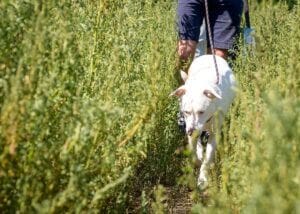Exploring Nature’s Potent Compounds: What are Triterpenes?
January 25, 2024
Written By: Earth Buddy Team

What are triterpenes? This is a complicated question, but we’re going to break it down the best we can. Now, you might be asking yourself, if we’ve never heard of them, how could they be so important? That’s an excellent question. Triterpenes have been used for centuries in Asian countries, but scientists have only discovered what they are in recent years as they gather information regarding medicinal mushroom species.
What Are Triterpenes?
Triterpenes, a class of compounds found in nature, are characterized by their extensive structural diversity and varied biological activities. As you may imagine, triterpenes are terpenes, but instead of being alone, there are three terpene units bound together. They have 30 carbon atoms, which are polymerized to form six isoprene units.
Scientists have discovered that there are at least 5,000 triterpenes found in nature, and with at least 140,000 mushroom species out there, there’s still a lot to be examined. They’re also found on the outside of plants, in their roots or stems, fruit peels, and bark.
What is Squalene?
These compounds originate from squalene and present a compelling range of chemical structures. Squalene is found in various natural sources. It’s most famously obtained from shark liver oil, where it’s present in high concentrations. However, squalene is also found in a variety of plant sources, including olive oil, amaranth seed, rice bran, and wheat germ.
Squalene is a hydrocarbon, meaning it is composed entirely of carbon and hydrogen atoms. Its structure consists of a long chain of carbon atoms with double bonds and is classified as a triterpene. Squalene plays a crucial role in the biosynthesis of all plant sterols and animal sterols, including cholesterol in animals and various steroids in plants. It acts as a biochemical precursor to these compounds.
Biosynthesis of Terpenes from Squalene
The process of biosynthesis, which transforms squalene into triterpenes, is a complex and finely tuned sequence of biochemical reactions. This process occurs across a wide range of organisms, including bacteria, protozoans, plants, and fungi. Each step in this sequence involves specific enzymes, which are proteins that act as catalysts to speed up these chemical reactions without being consumed in the process.
Starting with squalene, these enzymatic reactions lead to the formation of various cyclic triterpenes. ‘Cyclic’ refers to the chemical structure of these compounds, which includes one or more rings – arrangements of atoms connected in a closed loop. This transformation involves the formation of carbocation intermediates – highly reactive species that facilitate the rearrangement of the carbon skeleton. The variety of enzymes involved in these reactions contributes to the immense diversity of triterpenes observed in nature. Each enzyme can cause slight changes in the structure of the compound it acts upon, leading to the creation of different triterpenes.
The process begins with the conversion of squalene into 2,3-oxidosqualene. This step is crucial as it sets the stage for the formation of the cyclic structure of triterpenes. Following this, a series of reactions known as cyclization occurs. Cyclization involves the bending and folding of the linear squalene molecule into one or more ring structures, a transformation that is crucial for the formation of the triterpene skeleton.
The resulting triterpene skeletons can then undergo further modifications, like the addition or removal of specific functional groups. These modifications are also enzyme-driven and contribute to the vast array of triterpenes found in nature, each with unique properties and potential biological activities.
Triterpene Biosynthetic Pathways
The biosynthesis of triterpenes is a multi-step, intricate biochemical process that primarily occurs through the mevalonic acid (MVA) pathway. This triterpene biosynthetic pathway is crucial in the formation of various isoprenoids, including triterpenes. At the outset of this process, squalene, a significant initial substrate, plays a foundational role.
The journey of triterpene biosynthesis begins with the combination of isoprenoid units with isopentenyl diphosphate (IPP) and dimethylallyl diphosphate (DMAPP) for enzymatic synthesis. These two molecules, IPP and DMAPP, are the basic five-carbon units that form the building blocks of terpenes.
In the MVA pathway, several enzymatic steps lead to the synthesis of IPP and DMAPP from simpler molecular activities, known as precursors. These molecules then undergo a series of condensation reactions, where multiple IPP and DMAPP units are linked together in a head-to-tail manner.
The sequential addition of these five-carbon units eventually leads to the formation of the 30-carbon compound known as squalene. Squalene synthesis is a key step in the triterpene biosynthesis pathway, as it marks the transition from linear to cyclic molecules.
Enzymatic Transformations
Once squalene is synthesized, it undergoes various enzymatic transformations. These transformations are facilitated by enzymes known as squalene epoxidases and oxidosqualene cyclases.
These enzymes catalyze the cyclization of squalene, a process that involves the formation of ring structures and marks the beginning of the creation of the diverse array of triterpenes. Each enzyme introduces specific changes to the squalene molecule, leading to different triterpene structures.
The resultant triterpenes can then undergo further modifications, such as oxidation and rearrangement, leading to an even greater diversity of triterpene structures. These modifications, catalyzed by other specific enzymes, add functional groups to the triterpene skeletons, altering their biological activity and making them useful for various physiological functions.
Triterpene Metabolism in a Nutshell
Triterpene metabolism encompasses the complex biochemical processes responsible for the synthesis, modification, and degradation of triterpenes in organisms, primarily in plant biology. Triterpenes, belonging to the larger family of terpenes, are notable for their significant biological functions and potential in therapeutic applications. As plant physiology research continues, advanced knowledge of plant biology and plant physiology will be learned. For now, here’s what scientists do know:
The biosynthesis of triterpenes starts with squalene, a linear precursor formed by linking two farnesyl pyrophosphate (FPP) molecules. FPP itself is synthesized from isopentenyl pyrophosphate (IPP) and dimethylallyl pyrophosphate (DMAPP), which are products of either the mevalonate pathway or the methylerythritol phosphate (MEP) pathway in plants.
The Transformation
The transformation from squalene to various triterpenes is achieved through a process called enzymatic cyclization. This process, facilitated by enzymes such as squalene epoxidases and oxidosqualene cyclases, leads to the formation of different triterpene skeletons, like lanosterol in animals and fungi, as well as other cyclic structures in plants.
These basic skeletons can then undergo a range of modifications including oxidation, rearrangement, and the addition of functional groups, leading to the diverse array of triterpenes found in nature. These modifications are enacted by various enzymes.
Degradation
Finally, the metabolism of triterpenes includes their degradation, where they are broken down into smaller compounds within the organism. This degradation, involving different enzymatic processes, is a natural part of the lifecycle of these compounds, completing the cycle of triterpene metabolism.
Structural Diversity of Triterpenes
About 200 distinct structural frameworks of triterpenes have been documented, and they are broadly categorized into the following categories:
- Acyclic triterpenes
- Bicyclic triterpenes
- Monocyclic triterpenes
- Tricyclic triterpenes
- Tetracyclic triterpenes
- Pentacyclic triterpenoids
Their structure gives triterpenes their unique chemical properties and differentiates them from other types of compounds. They’re categorized based on the number of cyclic structures they contain. The pentacyclic triterpenes, consisting of five C rings, tend to be the most prevalent, which shows their structural dominance in natural settings.
Illustrating the diverse nature of triterpenes are the lanostanes, cucurbitanes, and oleananes, each possessing unique characteristics and potential pharmacological effects. These variants represent the extensive structural and functional diversity inherent in triterpenes.
Diverse Groups of Triterpenes
Lanostanes, cucurbitanes, and oleananes are types of chemical compounds known as triterpenes, which are found in various natural sources. Then, there’s also ursane and lupane. Each of these compound types has unique structural characteristics and potential biological activities:
Lanostanes
These compounds are a group of triterpenes characterized by a specific molecular structure known as the lanostane skeleton. Lanostanes are commonly found in fungi, especially in mushrooms like the Reishi (Ganoderma lucidum).
They are known for multiple properties, including supporting a normal inflammatory response, supporting normal cell function, and supporting proper balance of normal intestinal flora. Lanostanes are a subject of interest in pharmacological research due to potentially providing nutrients for a healthy body.
Cucurbitanes
Cucurbitanes are another group of triterpenes, named for their occurrence in plants of the Cucurbitaceae family, such as cucumbers, melons, and gourds.
These compounds have attracted scientific interest due to their diverse range of biological activities, which include helping support glucose metabolism, supporting normal cell function, and normal inflammatory pathways. Cucurbitanes have a unique structure that distinguishes them from other types of triterpenes.
Oleananes and Oleanolic Acid in the Plant Kingdom
Oleananes are triterpenes that are derived from the oleanane skeleton. They are widely distributed in the plant kingdom and are particularly abundant in certain herbs and trees.
Oleananes have been studied for promoting normal inflammatory pathways and helping reduce oxidative stress. One well-known oleanane triterpene is oleanolic acid, which is found in olive oil. Oleanolic acid has been researched for its potential benefits and many are still being uncovered.
Ursane
Ursane triterpenes in cannabis are part of a group of compounds characterized by a specific molecular formula known as the ursane skeleton. Research into ursane triterpenes has shown that they may help maintain a normal inflammatory response and normal cell activity.
Lupane
Lupane triterpenes, similarly, have a distinct molecular structure known as the lupane skeleton. As with ursane, the lupane triterpenes in cannabis contribute to the plant’s potential, but the specifics of their effects when derived from cannabis require future research.
Benefits of Triterpenes for Dogs
Triterpenes are organic compounds found in certain mushrooms and are known for their potential health benefits for dogs. These compounds have been recognized for their promoting normal inflammatory processes and supporting the immune system, which can significantly contribute to a dog’s overall well-being.
Triterpenes play a crucial role in promoting cellular health, supporting glucose uptake by the cells, and enhancing cardiovascular function. Additionally, they support a dog’s immune system and promote overall health, making them valuable additions to a dog’s diet.
Research has shown that triterpenes can aid in promoting normal inflammatory pathways in dogs, which is especially beneficial for canine companions dealing with occasional discomfort. By incorporating mushrooms rich in triterpenes into a dog’s diet, pet owners can help support joint flexibility and mobility, in addition to supporting their dog’s immune system.
Triterpenes are also known for their potential to enhance liver and kidney function in dogs. The liver plays a crucial role in supporting the metabolic functioning of the liver, and triterpenes support normal function and health of the liver.
Additionally, triterpenes have been found to help support normal cardiovascular function. Triterpenes can contribute to enhanced cardiovascular health, supporting normal heart and vasculature functioning. This is particularly valuable for aging dogs, as it offers a natural and complementary approach to supporting and promoting long-term health.
Antioxidants in Triterpenes
Triterpenes are crucial players in the realm of antioxidants, supporting and promoting long-term health like hydroxyl free radicals and superoxide anions. Antioxidants are particularly notable in the triterpenoids extracted from the authentic Sanghuangporus sanghuang mycelium.
These compounds have shown remarkable proficiency in supporting and promoting long-term health. This effectiveness suggests they could reduce the negative effects of oxidative stress.
The unique structures of triterpenes allow them to exhibit a broad spectrum of biological activities. The diverse actions of triterpenes in the body further highlight the importance of compounds with antioxidants.
Apoptosis and Induced Cell Cycle Arrest Halt Cell Proliferation
These compounds have been noted for several pharmacological activities, including inducing apoptosis, also known as programmed cell death or induced cell cycle arrest. Triterpenes can interact with various cellular mechanisms that control the cell cycle. The cell cycle is a series of phases that a cell goes through as it grows and divides. By interfering with this cycle, triterpenes can halt cell proliferation, especially those that are growing abnormally.
Another significant function of triterpenes is the modulation of proteins in the Bcl-2 family, which play a pivotal role in regulating apoptosis. Research indicates that certain triterpenes may elevate levels of pro-apoptotic proteins such as Bax and Bak in this group, while simultaneously reducing levels of anti-apoptotic proteins like Bcl-2 and Bcl-xl. These pharmacological activities involving alteration in protein levels can tip the balance in favor of cell death in abnormal cells.
Pharmacological Activities Involving Reactive Oxygen Species
Triterpenes have been observed to enhance the production of Reactive Oxygen Species (ROS). These small, highly reactive molecules can inflict damage on DNA and other critical cellular structures. In the context of abnormal cells, some triterpenes appear to promote ROS production, triggering a process known as apoptosis.
Additionally, triterpenes play a role in promoting the stimulation of caspases, enzymes that are essential for the execution of apoptosis induction. There is growing evidence suggesting that certain triterpenes can activate these enzymes within the abnormal cells, supporting the process of cell death.
Diverse Sources of Triterpenes
Triterpenes are found in a wide variety of natural sources, including plants, fungi, and certain marine organisms. Here are some common sources of triterpenes:
Scientists Developing Synthetic Triterpenoids
Before we talk about where triterpenoids are found naturally, it’s important to note that synthetic triterpenoids are now being developed in labs in an effort to mimic the ones found in nature. Due to this complex molecule’s range of benefits, scientists have interest in developing synthetic triterpenoids of their own for human, and eventually animal, benefit.
Triterpenes in Various Plant Species
Triterpenes are widespread in the plant kingdom, particularly abundant in medicinal herbs and trees, where they play crucial roles and contribute to the plants’ therapeutic properties. For instance, the ginseng plant species is renowned for its rich content of triterpenoid saponins, known as ginsenosides or triterpene glycosides (signal transducers). Triterpenoid saponins are a major factor in ginseng’s wide range of properties, including its adaptogenic effects, which assists the body in combating environmental pollutants.
Other plants notable for their triterpene content include licorice, which contains triterpenoid saponins like glycyrrhizin. Triterpenoid saponins contribute to licorice’s taste as a natural sweetener (this triterpenoid saponin is only found in licorice) and are also responsible for promoting normal inflammatory pathways and helping support liver function.
Ginkgo biloba, another plant rich in triterpenes, particularly ginkgolides, exhibits properties that may support cognitive function and supporting normal circulatory function.
Centella asiatica, commonly known as Gotu Kola, is also well-known for its triterpene content, including asiaticoside and madecassoside. These compounds are believed to contribute to the plant’s compounds promoting healthy skin. Triterpenes in Centella asiatica are also thought to promote normal inflammatory signaling pathways.
Triterpenes found in these plants are not only key to their potential health benefits but also represent a significant area of interest in pharmaceutical sciences and nutraceutical research. Their diverse structures and biological activities have led to their use in traditional medicine systems across the world and continue to inspire modern scientific studies aimed at understanding and harnessing their potential.
Various Species of Mushrooms
Some species of mushrooms are rich sources of triterpenes, especially those used in traditional medicine. The Reishi mushroom (Ganoderma lucidum) and the Chaga mushroom (Inonotus obliquus) are well-known for their high triterpene content which is why the vast majority of research is performed on these two species. We’ll discuss this further later in the article.
Lichens and Mosses Contain Triterpenes
Triterpenes, in addition to being prevalent in various plants, are also found in lichens and mosses, where they play unique roles. Lichens, in particular, are intriguing organisms that are actually symbiotic associations between fungi and algae or cyanobacteria. They produce triterpenes, which contribute significantly to their survival and biological functions.
The presence of triterpenes in lichens has made them an object of interest, especially in the field of traditional medicine. Many cultures around the world have utilized certain lichen species for their beneficial properties, which are often attributed to the bioactive triterpene compounds they contain. These triterpenes in lichens can vary widely in structure and function, leading to a range of biological activities associated with plant growth. For example, some triterpenes found in lichens have been studied for promoting the body’s innate resistance to pathogens.
The study of triterpenes in lichens is not just limited to their potential to promote mental and physical well-being; these compounds also helps reduce the effects of normal environmental stress on lichens. They can help shield the lichen from harmful UV radiation, extreme temperatures, and desiccation.
Mosses, another group of non-vascular plants, also produce triterpenes, although the diversity and roles of these compounds in mosses are less well-understood compared to lichens and higher plants. Like in lichens, triterpenoid saponins in mosses are believed to contribute to the plants’ defense mechanisms and may offer medicinal properties.
Triterpenes in Marine Organisms
The fascinating world of marine biology also showcases the presence of triterpenes, particularly in various species of sponges and sea cucumbers. The marine environment, with its unique ecological conditions and challenges, has led to the evolution of triterpenes with structures and properties that are often distinct from those found in terrestrial organisms. Many marine triterpenes have yet to be discovered.
Triterpenes in Fruits and Vegetables
Triterpenes, while prominently featured in medicinal plants and mushrooms, are also found in a variety of fruits and vegetables, albeit generally in lower concentrations with a significant reduction of beneficial compounds. But they are still important due to their beneficial properties. These naturally occurring compounds contribute to the nutritional benefits of many common foods.
Ursolic Acid in Apples
Apples are a notable source of triterpenes, particularly in their peel. Ursolic acid is one such triterpene found in apples, known for its potential health benefits, including promoting normal inflammatory pathways. The presence of ursolic acid in apples has been linked to their ability to promote muscle integrity and help maintain blood glucose levels within normal range. Ursolic acid also helps support proper weight management.
Liminoids in Citrus Fruits
Citrus fruits, such as oranges, lemons, and grapefruits, contain various triterpenes. These compounds, found in the peel and the pulp, include limonoids like limonin. Limonoids are known for their bitter taste, but they also have potential health benefits, including helping maintain optimal health as well as supporting and promoting long-term health.
Lupeol in Cabbage
Cabbage and other cruciferous vegetables contain triterpenes that contribute to their health-promoting properties. These triterpenes include lupeol, which has shown to promote normal inflammatory pathways and support the immune response. The presence of lupeol and similar compounds in cabbage is linked to the vegetable’s potential in supporting normal bodily functions and as a part of a heart-healthy diet.
The presence of triterpenes in these fruits and vegetables adds to their overall benefits. These compounds are part of the complex array of phytochemicals found in plant-based foods that contribute to their role in helping maintain the general health of all ages.
The study of triterpenes in fruits and vegetables is an area of growing interest, as researchers continue to uncover the various ways these compounds can impact the omnivorous mammalian body.
Triterpenes in Reishi Mushrooms
Reishi mushrooms, also referred to as the “mushroom of immortality,” contain high levels of triterpenes, making them an excellent source to help support your pet’s physical and mental well-being.
Reishi contains a number of triterpenes, with the most prevalent being ganoderic acids, sterols, and lucidenic acids. Keep in mind that these are only the most prominent; there are actually over 140 triterpenes in reishi alone that can be found in the fruiting bodies, spores, and mycelia in addition to the lucidenic acids, sterols, and ganoderic acids.
By incorporating Reishi mushrooms into a dog’s diet, pet parents can provide their furry friends with a natural means of supporting their dog’s immune system.
More Mushroom Species Containing Triterpenes
Other mushrooms like Turkey Tail mushroom for dogs and cats, Lion’s Mane, and Agarikon also offer rich concentrations of triterpenes, each contributing uniquely to supporting the immune health of dogs. The chemical structure of triterpenes in mushrooms can vary, which influences their biological activities. For example, chaga mushrooms have two main types of triterpenes known as inotodiol and trametenolic acid, which have been shown to help maintain normal histamine levels.
Extracting Important Triterpenoids
Challenges in the isolation and structural elucidation of triterpenoids have been addressed through technological advancements, enhancing triterpenoid chemistry research and opening avenues for their utilization in overall health and wellness.
Take, for example, the process of getting triterpenoids from a specific type of mushroom mycelium called Sanghuangporus sanghuang. Scientists have used advanced methods like the Box-Behnken experimental design and the response surface method to find the best way to extract these compounds.
Thanks to these methods, they’ve figured out the ideal conditions for extraction and have shown that the triterpenoids provide antioxidant protection. This shows how far we’ve come in being able to efficiently extract and use triterpenoids.
These advancements not only contribute to the understanding of triterpenes’ potential as natural antioxidants but also pave the way for their utilization in the development of novel chemical entities.
Choosing High-Quality Mushroom Supplements
When choosing high-quality mushroom supplements, you should look for a company that plants natural products and has the following:
- Organic growth
- High-level of purity
- 3rd party tested
- Full-spectrum
Why Choose Companies That Plant Natural Products and Use An Organic Approach
When selecting functional mushroom supplements for dogs and cats, it’s crucial to opt for those made from organically grown mushrooms. Organic cultivation ensures that the mushrooms are grown without the use of synthetic pesticides, herbicides, or other harmful chemicals that could potentially be harmful to your dog’s health.
Organically grown mushrooms are cultivated in a natural environment, often without the use of genetically modified organisms (GMOs) or artificial fertilizers. This method of farming not only supports sustainable agriculture practices but also can lead to a higher quality product.
Mushrooms grown organically are believed to be more potent and purer, retaining a higher level of beneficial compounds compared to those grown conventionally.
The absence of harmful residues in organically grown mushrooms means there’s a lower risk of these substances accumulating in your dog’s body over time.
By choosing organic mushrooms for dogs and cats, you are also contributing to environmental conservation, as organic farming is generally more eco-friendly. It promotes biodiversity, soil health, and reduces pollution from chemical runoff.
Check Purity Level With 3rd Party Testing
Third-party testing involves an independent organization, not affiliated with the supplement manufacturer, verifying the product’s quality. This allows you to confirm that the supplement actually contains the types of mushrooms and the amounts listed on the label. This is essential to ensure that you are getting the specific benefits from the specific mushroom species claimed by the product.
These tests check for contaminants such as heavy metals, pesticides, or harmful microbes. Mushrooms are known to absorb and accumulate substances from their growing environment, so testing ensures that the supplement is safe for your dog’s consumption.
Brands that invest in third-party testing are often more reliable and trustworthy. It shows that they are committed to providing safe, high-quality products and are willing to be transparent about their product’s quality.
Mushroom Products With Transparency
Earth Buddy has carefully selected the mushrooms for their five-mushroom blend based on extensive scientific research. In all of their products, an organic blend of mushrooms and mycelium, featuring Agarikon, Cordyceps, Lion’s Mane, Reishi, and Turkey Tail are incorporated. They’re specifically designed for dogs and cats.
Why Full Spectrum Mushrooms For Dogs & Cats Are Important
While both the beta-glucans from the fruit body of mushrooms and the compounds in mycelium offer numerous health advantages, they each have distinct qualities offering promising results when combined. Together, they work in synergy to create a comprehensive effect.
Mycelium is found to contain a broader range of beneficial compounds compared to the fruiting body, yet both parts significantly contribute to overall health. Take the Reishi mushroom, for instance. Its fruiting body is rich in triterpenes, compounds known for:
- Supporting the immune system
- May help relieve inflammation associated with normal daily exercise and activity
- Helping support liver function
- Helps maintain normal emotional balance
However, to fully benefit from the Reishi mushroom and access all its antioxidants, both the fruiting body and mycelium must be consumed allowing all the compounds to work synergistically.
A full-spectrum mushroom product goes even further. It includes not just the mycelium and fruiting body but also all extracellular compounds produced throughout the mushroom’s life cycle. These extracellular compounds originally served to protect the mushroom from other organisms in its natural soil environment.
Instead of focusing on one specific part of the mushroom, a full-spectrum approach utilizes as much of the mushroom as possible. This method ensures you get the maximum benefits from every aspect of the mushroom.
Mushroom Products from Earth Buddy
Earth Buddy Pet offers several mushroom products, including:
Focus+Immune Mushroom & Hemp Capsules
Earth Buddy’s Focus + Immune Mushroom and Hemp Capsules are an adaptogenic blend of organic, full-spectrum mushrooms and full-spectrum hemp extract, containing cannabidiol and other cannabinoids, and terpenes.
There aren’t any chemicals used during the extraction process. Instead, sub-zero temperatures are used for extraction and low heat for activating beneficial compounds in the CBD, so all beneficial compounds can be preserved in the mix.
Immunity–Organic Mushrooms for Dogs & Cats
The Immunity mushroom powder for dogs and cats is a functional food topper made with a pure, triple-extracted, organic mushroom blend with 5 different mushroom species. This product is made with freeze dried fruit body and mycelium extract to provide dogs and cats with a full-spectrum product containing bioavailable compounds that were grown in the USA.
They were grown on organic millet, organic rye berry, and oak. Following growth, they were triple extracted as a liquid, then freeze-dried into a powder.
For further reading, we recommend:
- https://www.sciencedirect.com/topics/chemistry/triterpene
- https://pubmed.ncbi.nlm.nih.gov/20079412/
- https://www.ncbi.nlm.nih.gov/pmc/articles/PMC3057757/
- https://www.researchgate.net/publication/41039079_Effects_of_triterpenes_on_the_immune_system
- https://www.nature.com/articles/s41598-019-43886-0
- https://www.ncbi.nlm.nih.gov/pmc/articles/PMC9000726/
- https://www.ncbi.nlm.nih.gov/pmc/articles/PMC9019815/
- https://www.sciencedirect.com/topics/pharmacology-toxicology-and-pharmaceutical-science/triterpenoid
- https://www.ncbi.nlm.nih.gov/pmc/articles/PMC9100339/
- https://www.frontiersin.org/articles/10.3389/fpls.2019.01523/full
- https://www.ncbi.nlm.nih.gov/pmc/articles/PMC3271404/
- https://www.mdpi.com/2218-273X/13/1/24
- https://www.frontiersin.org/articles/10.3389/fbioe.2020.00347/full
- https://www.ncbi.nlm.nih.gov/pmc/articles/PMC6269678/
- https://pubmed.ncbi.nlm.nih.gov/24498976/
- https://link.springer.com/article/10.1007/s10725-022-00818-9
- https://www.ncbi.nlm.nih.gov/pmc/articles/PMC6891332/#:~:text=Oleanane%20and%20ursane%20triterpenes%20have,externalization%20of%20phosphatidylserine%2C%20indicating%20apoptosis.
You Might Also Enjoy
Reactive dog barking may sound intimidating, but it’s important to differentiate it from dog aggression.…
Your dog’s skin is their largest organ making dog skin care a crucial part of…
Like us, our dogs, and other mammalian species, cats have an endocannabinoid system. This system…








